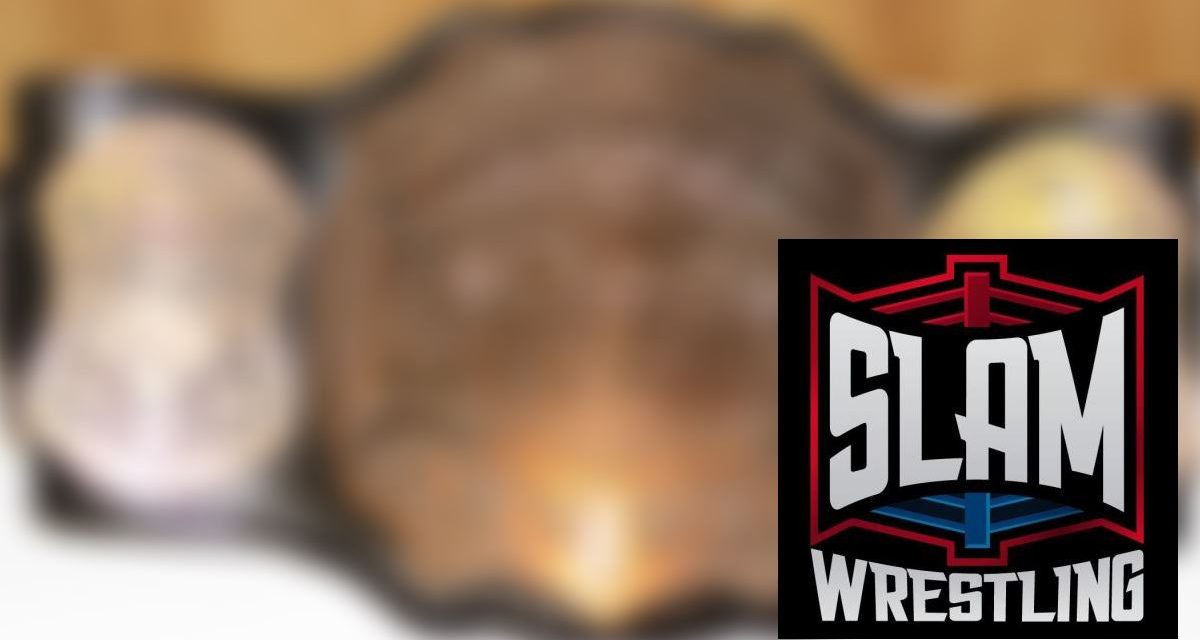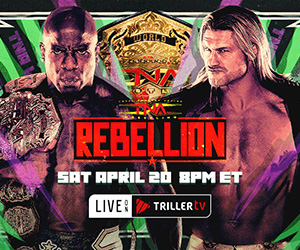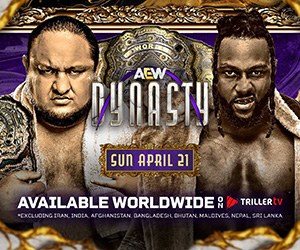Over a year ago, SLAM! Wrestling Producer Greg Oliver asked me if I would write an article about the then newly-resurfaced Pacific Coast Heavyweight Wrestling Champion belt that was used by Joe Malcewicz’s California promotion from 1936 until 1962, when the promotion ceased operations. As mentioned in that article wrestlers including Bronko Nagurski, Ray Steele, Bill Longson, Frank Sexton, Fred Blassie, Vincent Lopez, Jim Casey, Sandor Szabo and Dean Detton wore the belt emblematic of the Pacific Coast titlist.
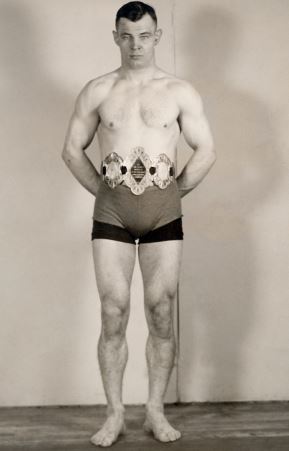
Joe Malcewicz
In my original article, I speculated that Ad Santel donated his belt for the 1936 Malcewicz tournament. My hypothesis was based on the facts that Santel was one of Joe’s promoters and that Santel had been advertised as far back as 1916 as the Pacific Coast Heavyweight Wrestling Champion. Additionally, a July 7, 1934, San Francisco newspaper headline stated, “Santel hangs Up Gold Belt for Mat King” and further proclaimed that the upcoming mat tournament’s winner would own the “Pacific Coast heavy weight title.”
Enter Ruslan Pashayev, a Russian-born immigrant to the United States, now living in Delaware, Ohio, just north of the former Al Haft/Billy Wolfe stomping grounds of Columbus. Ruslan emailed me to inform me that his hobby is researching pre-1940 wrestling title belts. Wow, I had no idea that wrestling researchers specialized to that degree. He speculated that the origin of the belt may date back to the 1880s judging by the intricate detailing or “chasing” on the silver and gold plates, the hinging of the plates and the rhomboid shape of the center plate. These are details that would escape a casual observer or even a serious collector such as me.
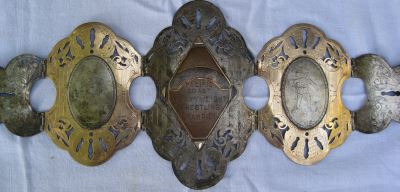
A close-up of the belt.
Ruslan, who in real life is a ballroom dancing competitor and instructor, gave me a crash course in belt history research and told me, “Belts can speak, if we will only listen.” Such a phrase sounded more like a supernatural approach to belt research. However, more than a year later, I think he is correct IF one is willing to exert mythical effort over a long timeframe. With the further support of renowned wrestling historians such as Don Luce, Dan Westbrook, Steve Yohe, John Pantozzi, Rock Rims, Jimmy Wheeler, Tim Hornbaker, Mark Hewitt and Scott George, the belt’s lineage from 1926 to 1962 has been “mostly” established. On January 23, 2017, Steve Yohe emailed me and stated, “Of all the famous belts left I would say only the [Lou] Thesz belt out ranks it. Nothing else looks like it. Well a daughter of Londos has one of Jim’s belts … that might be important too.”
When I first purchased the belt, a Malcewicz family member mentioned that this belt may have been Joe Malcewicz’s world title belt. I foolishly dismissed that idea because the center plate contained the Pacific Coast designation. It never occurred to me that a skilled jeweler can easily replace that central section of the main plate. Later we obtained photographic evidence which revealed that section to having been replaced at least several times.
Ten years after winning his world title belt in Boston, Joe Malcewicz organized a tournament to establish the Northern California Heavyweight Wrestling Champion. Participating in this November 3, 1936, tourney were wrestlers such as Lou Thesz, Vic Christy, Al Stecher (no relation to the Scissors King), Bill Longson, John Spellman, Casey Kazanjian and other notables of that era. The final match to determine the winner was between Billy Hansen (Hanson) and Nick Lutze. Joe Malcewicz appeared in the San Francisco newspaper placing the belt around Hansen’s waist. Joe Malcewicz won the belt via a 1926 Boston tournament and ten years later presented it to another tournament winner, “Sliding” Bill Hansen, as he was sometimes billed.
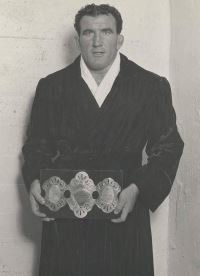
Jim Casey with the newly-won Pacific Coast title.
Newspaper accounts from 1936 assert that Sandor Szabo was the Pacific Northwest champion following a tournament win in Vancouver, British Columbia. However, we could find no references to such a tournament so whether it actually occurred is indeterminable at this time. Szabo did win an August 26, 1936, Portland, Oregon, tourney to determine an opponent for world champion Dave Levin. Regardless, on January 20, 1937, a match between Hansen, at that point being mainly billed as the California champion, and Szabo, announced as the Pacific Northwest champion, took place to determine which wrestler would become the newly minted Pacific Coast Heavyweight Wrestling Champion titlist. From that point onward, the belt that Hansen used to represent the Northern California Championship became the Pacific Coast Heavyweight Wrestling Champion’s belt.
Ruslan was persistent in trying to find out where Joe Malcewicz obtained such a beautiful belt for his 1936 tournament. He scoured newspaper articles from all over the country and came up empty-handed. Finally, we decided to send a request to the Hesburgh Library at Notre Dame University, which houses perhaps the largest repository of professional wrestling data and memorabilia in the world. There is a minor fee involved and the library may take up to a month to access whatever information that is being sought. It was well worth the wait and the small remuneration to obtain the object of my obsession — a photographic image of Joe Malcewicz wearing the belt that now rests in my curio cabinet. In the photograph, the belt bore the inscription, “Joe Malcewicz, World Heavyweight Wrestling Champion.”
Promoter Paul Bowser’s Boston tournament to determine a world champion brought Malcewicz and Swedish champion Alex Lundin together in a match on February 8, 1926. After the event, the beautiful title belt was awarded to Joe along with “$1,500.00.” Newspaper accounts of professional wrestling are notoriously inaccurate and the representations regarding this belt were no exceptions. One source stated that Bowser had this belt made especially for the new world champion at a cost of $1,000.00, a hefty sum in 1926. Another account reports that the belt was awarded by Tex Rickard, the famous boxing and wrestling promoter who co-promoted with Jess McMahon (the grandfather of Vincent K. McMahon of WWE) at Madison Square Garden. Lastly, another article declares that the belt was awarded by the Massachusetts Athletic Commission.
On March 11, 1926 world champion Joe Stecher was brought to Boston to face an “unknown” wrestler, who Stecher’s camp assumed would be Jake Brissler. However, the unknown wrestler turned out to be Joe Malcewicz, who was sitting at ringside in street clothes. When the Utica Panther entered the ring and began to take off his clothes, Stecher ran out of the ring assuming a double-cross was in progress. Malcewicz’s claim to the world title was strengthened by this forfeit by Stecher. Stecher’s camp later said that they were not concerned about Malcewicz’s wrestling abilities but rather Leon Burbank, a Bowser appointed referee.
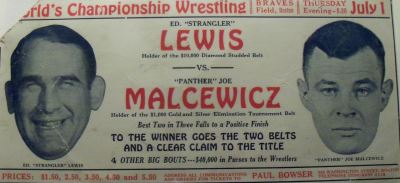
Strangler Lewis vs. Joe Malcewicz unification title match ink blotter ad.
Strangler Lewis and Joe Malcewicz had a highly publicized July 1, 1926 unification match in Boston’s Braves Field. The advertisement for this match stated that the winner would receive Lewis’ “$10,000 Diamond Studded Belt” and Joe’s “$1,000 Gold and Silver Elimination Tournament Belt.” In addition to the two belts, the winner would receive the “Clear Claim to the Title.” Almost needless to mention, the bout ended in a draw after each man had won one fall and the match was stopped at 2:00 a.m. during the third fall.
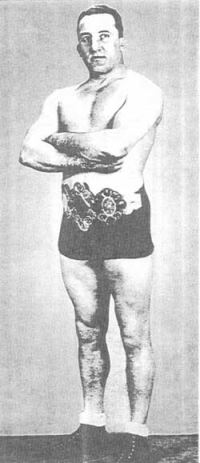
Al Mercier with New England belt.
The belt has also been used to serve as the New England title. An article published in a Lowell, Massachusetts, newspaper on December 15, 1933, mentions Al Mercier as wearing a “gaudy belt.” A contemporaneous photograph shows Mercier wearing the same belt that Malcewicz used as world champion but Mercier wore it as the New England champion. Perhaps Bowser still owned Malcewicz’s world title belt and repurposed it for the New England championship. However, it is plausible that Joe Malcewicz lent it to Mercier for the purpose of a publicity picture and for public exhibition during a few title matches, according to newspaper accounts mentioning the “gaudy” prize. Other wrestlers who held the New England title include Bull Martin and Pat Fraley but no pictures of them with the belt have yet been discovered.
There is a likely precedent for Malcewicz lending the belt out for publicity purposes as a January 21, 1927 Schenectady Gazette newspaper shows a picture of boxer James “Red” Herring wearing the belt. Herring was a junior welterweight who had a disputed claim to the world title.
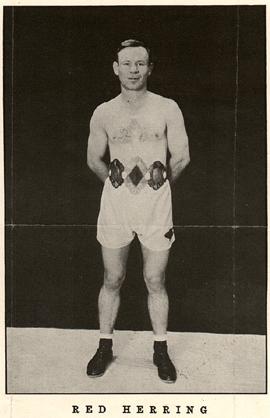
Red Herring borrows the belt.
You may wonder what the possible connection between Malcewicz and Herring might be. In the late 1920s, the Paducah, Kentucky, native Herring moved to Joe Malcewicz’s hometown of Utica, New York, where Herring ran a gym and promoted boxing. The coincidence between Joe winning the belt in 1926 and his fellow Utican wearing it in a picture published in a January 1927 newspaper logically assumes Malcewicz helping his friend enhance his publicity photograph. Incidentally, Joe’s brother and co-promoter Frank Malcewicz was not only a wrestler but also tried his hand at professional boxing in 1929. Although unsuccessful in his three documented professional bouts, it is interesting to speculate if Herring trained Frank in the manly art. Frank’s three boxing matches all took place in 1929 and were fought in Los Angeles, Boston and Syracuse. Perhaps Frank was capitalizing on his last name, as his brother Joe was well-known in sporting arenas all over America at that time.
Through Rulsan’s research, his engineering design background and his intuition, the belt may have been in existence for 40 years prior to the 1926 picture of Malcewicz wearing it following Bowser’s Boston tournament. Time and a lot more investigative probing may eventually uncover the specific origins of this honest-to-goodness piece of wrestling’s gold and silver history.
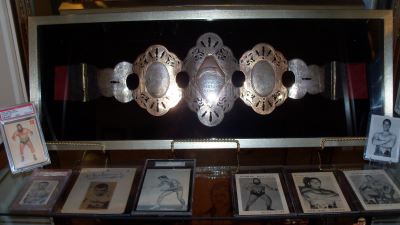
Dr. Bob Bryla’s current display of the Joe Malcewicz world title belt.
RELATED LINKS
Bob Bryla, a resident of Joe Malcewicz’s hometown of Utica, New York, is a retired Chiropractor and Physical Therapist who has collected wrestling memorabilia for six decades. He can be reached at bryfour@hotmail.com. Ruslan Pashayev continues his career in ballroom dancing competition and instruction and can be reached at ruslan-pashayev@yandex.ru.
